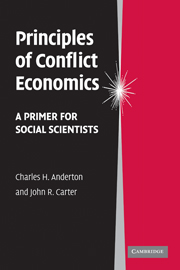Book contents
- Frontmatter
- Contents
- List of Figures
- List of Tables
- Preface
- 1 Introduction: Definition and Scope of Conflict Economics
- 2 Production Possibilities and the Guns versus Butter Trade-Off
- 3 Rational Choice and Equilibrium
- 4 Fundamentals of Game Theory
- 5 A Bargaining Model of Conflict
- 6 Conflict between States
- 7 Civil War and Genocide
- 8 Terrorism
- 9 Geography and Technology of Conflict
- 10 Arms Rivalry, Proliferation, and Arms Control
- 11 Military Alliances
- 12 Conflict Success Functions and the Theory of Appropriation Possibilities
- Appendix A Statistical Methods
- Appendix B A More Formal Bargaining Model of Conflict
- References
- Author Index
- Subject Index
5 - A Bargaining Model of Conflict
Published online by Cambridge University Press: 05 June 2012
- Frontmatter
- Contents
- List of Figures
- List of Tables
- Preface
- 1 Introduction: Definition and Scope of Conflict Economics
- 2 Production Possibilities and the Guns versus Butter Trade-Off
- 3 Rational Choice and Equilibrium
- 4 Fundamentals of Game Theory
- 5 A Bargaining Model of Conflict
- 6 Conflict between States
- 7 Civil War and Genocide
- 8 Terrorism
- 9 Geography and Technology of Conflict
- 10 Arms Rivalry, Proliferation, and Arms Control
- 11 Military Alliances
- 12 Conflict Success Functions and the Theory of Appropriation Possibilities
- Appendix A Statistical Methods
- Appendix B A More Formal Bargaining Model of Conflict
- References
- Author Index
- Subject Index
Summary
Economics involves the study of choices under conditions of scarcity. Whereas traditional economics assumes that choices are from among peaceful alternatives, conflict economics recognizes that some alternatives are violent or potentially violent. In this chapter we continue the move from traditional economics to conflict economics by sketching a simple economic model of conflict. The graphical model presented here is due originally to Hirshleifer (1995, pp. 172–175); more formal versions are available in Skaperdas (2006) and in Appendix B. Because the model is broadly consistent with what is known in political science as the bargaining (or rationalist) theory of war (Fearon 1995), we refer to it hereafter as Hirshleifer's bargaining model. Although by no means complete, the model provides a simple but effective framework for thinking systematically about the elements of conflict, some of the prominent explanations for war, and the possible effects of third-party intervention.
Elements of Conflict
Suppose that a disputed resource is to be divided between two players A and B. The players might be nation-states disputing territory, a government and a rebel group clashing over natural resources, or a government and a terrorist organization competing for control of a population. The players begin by diverting secure resources into arms, and then they divide the disputed resource either by fighting or by peaceful settlement. For simplicity, assume that each player chooses a level of arms that is the same whether fighting or settlement is anticipated.
- Type
- Chapter
- Information
- Principles of Conflict EconomicsA Primer for Social Scientists, pp. 67 - 82Publisher: Cambridge University PressPrint publication year: 2009



